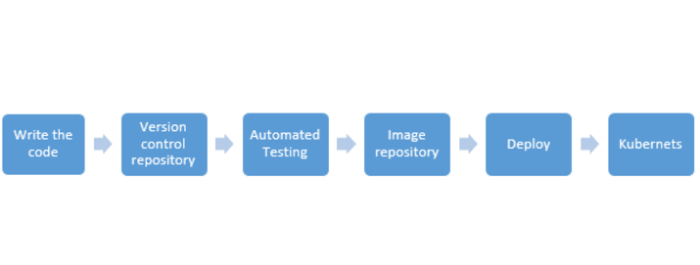
 Data Structure
Data Structure Networking
Networking RDBMS
RDBMS Operating System
Operating System Java
Java MS Excel
MS Excel iOS
iOS HTML
HTML CSS
CSS Android
Android Python
Python C Programming
C Programming C++
C++ C#
C# MongoDB
MongoDB MySQL
MySQL Javascript
Javascript PHP
PHP
- Selected Reading
- UPSC IAS Exams Notes
- Developer's Best Practices
- Questions and Answers
- Effective Resume Writing
- HR Interview Questions
- Computer Glossary
- Who is Who
What is GitOps?
Introduction
The GitOps methodology organizes and maintains the infrastructure for a project. By pushing a change to source control, a git commit triggers an update to cloud infrastructure or applications. In GitOps, changes in Git trigger builds and deployments of infrastructure and applications, so Git is the only source of truth. It is common for companies to use GitOps in conjunction with Kubernetes as their container orchestration platform.
In this article, we will explore Gitops in detail and why we need to use them
What is GitOps
GitOps is a subdiscipline of DevOps with similar aims, including speed and efficiency. DevOps practices have made DevOps a popular way of managing infrastructure. GitOps is a relatively brand-new idea focused on storing all the changes and files associated with a project in one Git repository.
Using GitOps, development teams specify infrastructure requirements in code. It can scale infrastructure automatically by building out code as infrastructure (IaC). GitOps improves speed and scalability. Each application deployment uses the same environmental configuration rather than a manual configuration.
GitOps automates the provisioning of infrastructure. Using GitOps, operations teams store configuration files as code (infrastructure as code) similarly to how teams use application source code. In the same way that application source code generates application binaries every time an application is built, GitOps configuration files generate the same infrastructure environment every time they are deployed.
What is GitOps Workflow
A pull request is the cornerstone of GitOps. An overview of changes for each branch should be available once a pull request is initiated. An overview of proposed changes can then be added, changes can be reviewed, labels can be added and other contributors can be mentioned. Contributors can then view any proposed changes after the pull request has been created by adding a commit from a topic branch. A pull request can be merged once everyone approves the changes.
Changing a container image, fixing an error in the environment, or updating specifications could lead to changes to an application or cluster. Using GitOps, users can fix any issues that arise with a pull request rather than through the underlying system, which makes troubleshooting faster. Other tools can be used in GitOps for Git pushes, development, and continuous integration like Jenkins X, GitHub, Bitbucket or AWS Code Deploy

What is the need for GitOps
The technology world is characterized by continuous innovation. Software development environments have been accelerated and scaled up with the advent of cloud computing. With DevOps, organizations were able to manage this agility efficiently and seamlessly delivering new software faster and better. These solutions included continuous integration/continuous delivery pipelines, version control systems, code review systems, and infrastructure management systems. However, automation was primarily focused on developers.
Automating development processes was made easy with all DevOps practices. However, infrastructure automation remains a complex process that requires the expertise of certified professionals.
In order to scale up and manage continuous deployments, modern infrastructure should be flexible and robust. Despite the fact that configuration management tools like Puppet, Chef, and Ansible make maintaining infrastructure easier, they do not seamlessly integrate applications with infrastructure as code. Moreover, they are not efficient enough to manage the entire cloud stack cannot be managed by them, as well. This is an ideal application for GitOps.
The GitOps framework provides developers with an easy way to manage infrastructure automation by declaring infrastructure code in a Git repository. By integrating Infrastructure-As-Code and applications, GitOps enhances the functionality of IaC tools by providing a centralized control point for managing infrastructure as well as apps running on it.
Advantages of GitOps
Provides enhanced security and compliance
With GitOps, teams can manage infrastructure changes using a single platform, reducing downtime and outages so developers can continue to work without compromise.
Reliability
CI/CD pipelines can incorporate code testing into your services since they are defined declaratively through code. The integration allows you to enable approval, testing, and rollback processes which can improve the overall reliability of your applications and mean time to recovery when changes are deployed.
Deployments are quicker
Continuous integration is enabled by open-source technology to ensure an expedient deployment process. With quicker releases, teams are able to respond to customer needs more quickly.
Infrastructure-wide standardization of operations
By implementing GitOps across apps, deployments, and add-ons, you can ensure an end-to-end workflow that is Git-centered throughout your infrastructure, which facilitates change management. CI/CD pipelines are also more visible with it.
Reduced manual oversight
GitOps allows software teams to spend less time handling repetitive tasks and more time on development and application delivery. Due to the rollback functionality, downtime is reduced.
Conclusion
Software infrastructure management and application code delivery are changing with GitOps. Jumping on board earlier and using GitOps benefits your software development lifecycle in the long run. Thank you for reading this article. I hope you found it useful and insightful.

